5 bird with red head and brown body
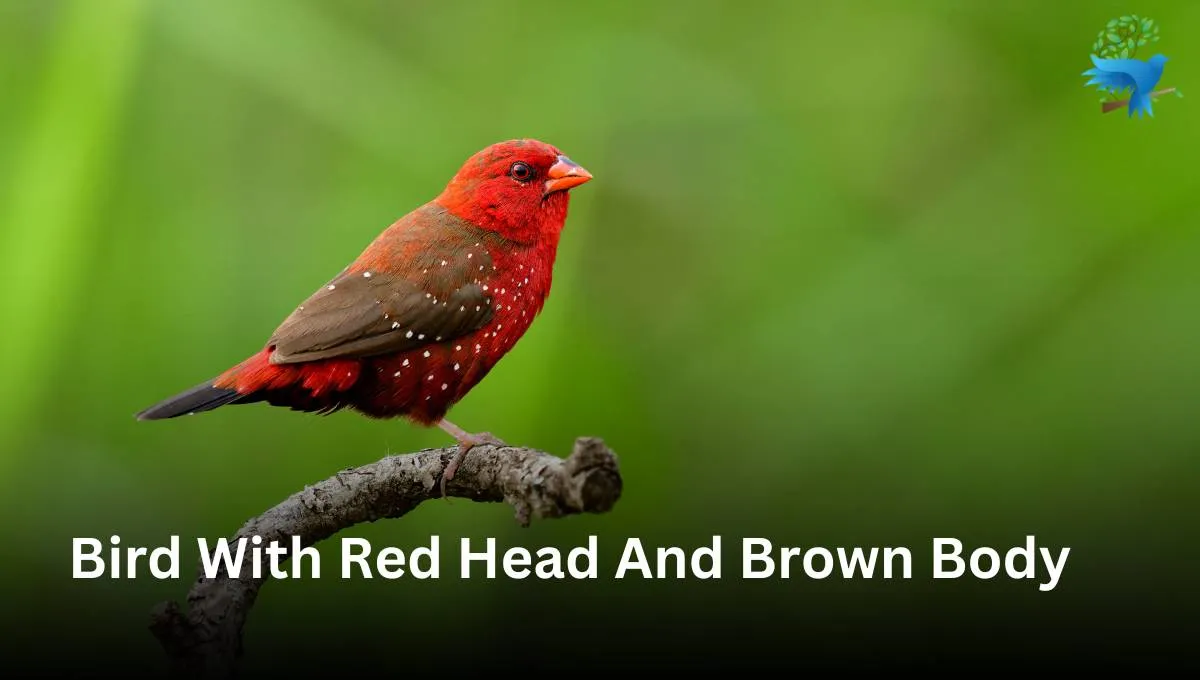
Among the many varieties of birds, there is a particularly interesting, colorful subpopulation.
The brilliant red-headed birds are striking and act as elegant, bright lights. Both casual viewers and bird specialists are captivated by the spectacle created by their fiery crowns paired with earthy-colored bodies.
In this blog, we set out to find five amazing birds distinguished by their distinctive brown bodies and redheads.
Come along with us as we explore the world of creatures with red heads and brown bodies.
List of 5 Bird with Red Head and Brown Body
- Red Avadavat (Amandava Amandava)
- House Finch (Haemorhous Mexicanus)
- Cassin’s Finch (Haemorhous Cassinii)
- Red Junglefowl (Gallus Gallus)
- Lesser Redpoll (Acanthis Cabaret)
1. Red Avadavat (Amandava Amandava)
The Red Avadavat, also known as the red munia or the strawberry finch, belongs to the Estrildidae family and is about the size of a sparrow.
Its distinguishing features include a rounded black tail and a bill that turns red during certain seasons.
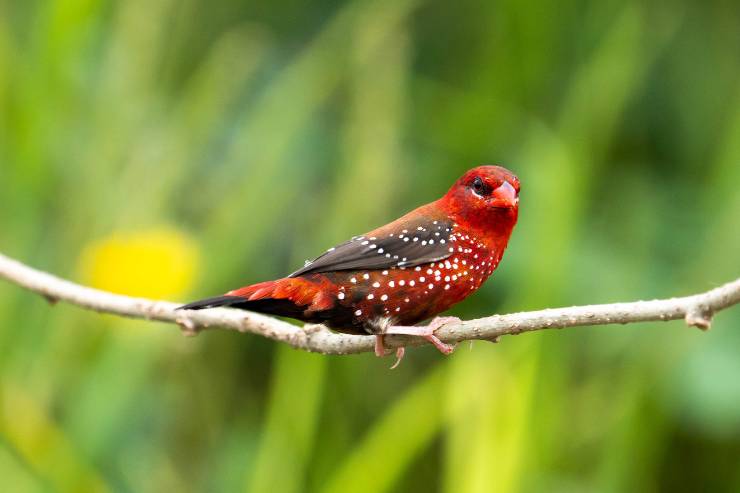
The bird displays a red rump, with breeding males showcasing red coloration on most upper parts, except for a black eye stripe, lower belly, and brown wings. White spots adorn the red body and wing feathers.
| Note: Red Avadavat is named after Ahmedabad, Gujarat, India, where it was historically traded as a pet. |
The lifespan of a red avadavat in captivity is 8–17 years. Currently, it is classified as a species of the least concern.
Size, weight, lifespan, and conservation status of Red Avadavat:
- Size: 9-10 centimeters (3.6-4 inches)
- Weight: 7-7.5 grams (0.24-0.26 oz)
- Life span: 8–17 years (in captivity)
- Conservation status: Least concern
Habitat: Due to the males’ vibrant plumage during the breeding season, red avadavats are commonly kept as cage birds in tropical Asia’s vast fields and grasslands.
Red Avadavats are primarily found in areas with long grasses or crops on level plains, frequently close to bodies of water.
Feeding: The Red Avadavat is named because of its crimson hue and white dots resembling strawberry seeds.
It moves in small flocks and feeds on grass seeds in open spaces, particularly near water sources. However, it can also eat termites and other specific insects.
| Note: During the breeding season, insects make an excellent food source for Red Avadavat because they provide additional nutrients like protein. |
2. House Finch (Haemorhous Mexicanus)
The house finch, which belongs to the Fringillidae family of finches, is distinguished by its flat head, short body, and comparatively large beak.
Its tiny wings draw attention to its seemingly lengthy tail. Adult males’ cheeks and upper breasts are rosy red, while their backs, bellies, and tails are streaked with brown.
Their crimson rear end is easy to spot when they’re flying.
Adult females, on the other hand, are not red-colored; instead, they have a grayish-brown complexion with thick, hazy streaks and less pronounced facial features.
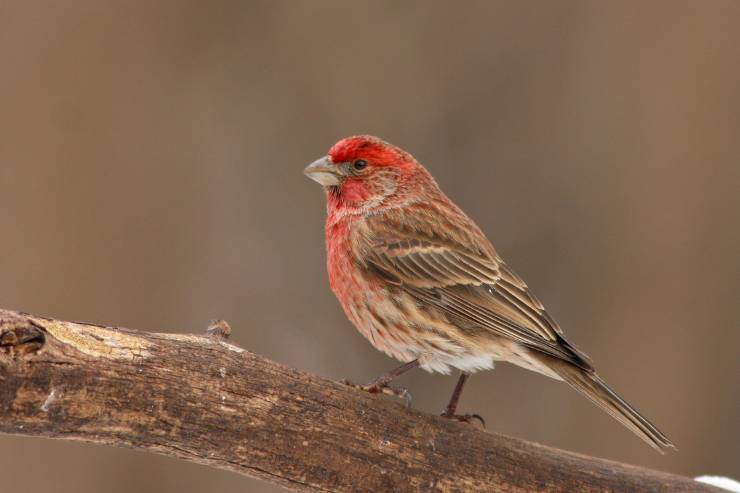
House finches in their natural habitat have a potential lifespan of over 11 years.
The worldwide breeding population is roughly 40 million, and they receive a low conservation concern rating of 6 out of 20 on the Continental Concern Scale, indicating a rising population trend.
Size, weight, wingspan, lifespan, and conservation status of House Finch:
- Size: 12.5-15 centimeters (5-6 inches)
- Wingspan: 20–25 centimeters (8-10 inches)
- Weight: 16–27 grams (0.56-0.95 oz)
- Life span: 11 years
- Conservation status: Least concern (Population rising)
Habitat: House finches are common birds in artificial environments. They can be seen in cities, miniature conifers, lawns, and buildings. In rural areas, they can also be seen near barns and stables.
Feeding: House Finches’ diet is mainly composed of wild plant materials such as wild mustard seeds, knotweed, thistle, mulberry, poison oak, and cactus.
They also eat fruits, buds, and seeds. In addition, House finches also consume cultivated fruits from orchards, such as figs, strawberries, blackberries, pears, plums, cherries, apricots, and peaches.
3. Cassin’s Finch (Haemorhous Cassinii)
The species Cassin’s Finch is a member of the genus Haemorhous and the family Fringillidae. Adult males have a brown body and a vivid rosy-pink color, especially on the crown.
However, females and youngsters are white and brown with noticeable dark streaks on the underparts and chest.
Both sexes usually have striped undertail coverts and a narrow white eyering. This species has a lifespan of 15 to 20 years, making its conservation status one of the least concern.
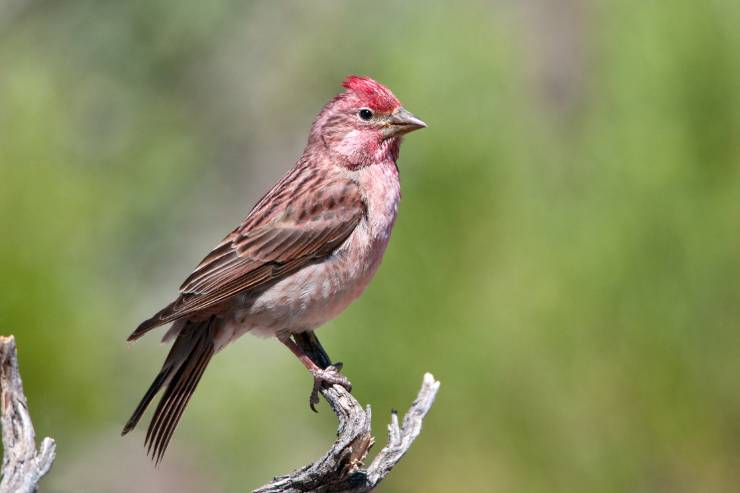
Size, weight, wingspan, lifespan, and conservation status of Cassin’s Finch:
- Size: 16 centimeters (6.3 inches)
- Wingspan: 25–27 centimeters (9.8-10.6 inches)
- Weight: 24–34 grams (0.81-1.2 oz)
- Life span: 15 to 20 years
- Conservation status: Least concern
Habitat: Cassin’s Finch, known for its rosy hue, is a common sight in the mountainous regions of western North America.
These birds can be observed in small groups, chirping and searching for food in tall evergreen forests and groves of quaking aspen.
Feeding: Although there have yet to be extensive studies on their diet, existing data suggests that they primarily consume plant-based foods, with a significant portion of their diet consisting of tree buds, including those of quaking aspen.
4. Red Junglefowl (Gallus Gallus)
The red junglefowl belongs to the Phasianidae family of tropical birds, which inhabits large areas of Southeast and South Asia.
The grey junglefowl, green junglefowl, and Sri Lankan junglefowl all have genetic variation of the chicken, which is descended from what was formerly known as the bankiva or bankiva fowl.
The male is easily identified by its bright plumage; it has long, glossy tail feathers. Its neck and back also have golden hackle feathers.
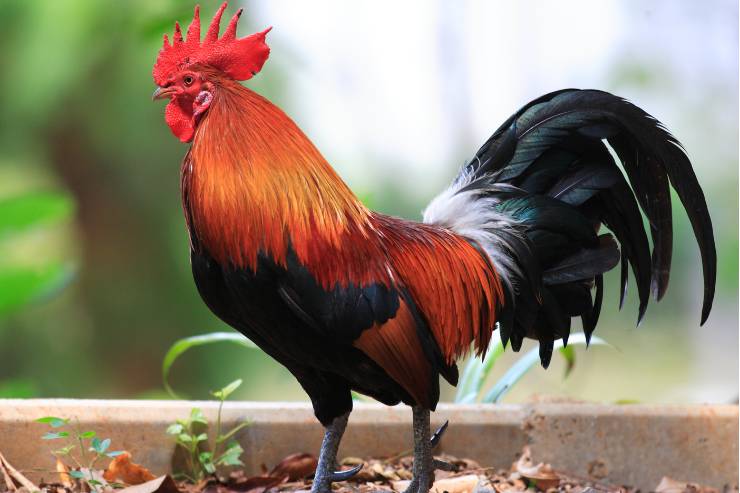
Its plumage is colorful, ranging from orange and brown to metallic green, red, gold, grey, white, and olive. Red Junglefowl has a red head.
The average lifespan of a Red Junglefowl is between 12 and 15 years. The IUCN now classifies red junglefowl as the least concern species.
Size, weight, wingspan, lifespan, and conservation status of Red Junglefowl:
- Size: 76.2 centimeters or 30 inches (in male) and 43.18 centimeters or 17 inches (in female)
- Wingspan: 80–100 centimeters (31.49-39.37 inches)
- Weight: 1.06 oz
- Life span: 12 to 15 years
- Conservation status: Least concern
Habitat: The Red Junglefowl is mainly found in areas with open terrain and thick undergrowth. They frequently go through woodlands in search of food supplies or clearings.
Feeding: The seeds, fruits, and nuts found on the ground are the primary food source for junglefowl.
They graze on insects and other arthropods, small reptiles like lizards, and even small mammals.
| Note: Red junglefowl look for fruits and seeds on trees rather than in the ground. |
5. Lesser Redpoll (Acanthis Cabaret)
A small member of the finch family, the lesser redpoll is easily identified by its brown coloring, prominent streaking, and small stature.
Many taxonomies, including Clements and the British Ornithologists’ Union, have accepted it as a different species even though it was formerly thought to be a subspecies of the common redpoll.
This bird, which has red streaks on its head and sometimes its breast, prefers to feed in trees upside down. Its life span is approximately 2 to 3 years.
Since it is expected to be locally abundant in its habitats, it is not regarded as globally threatened in terms of conservation.
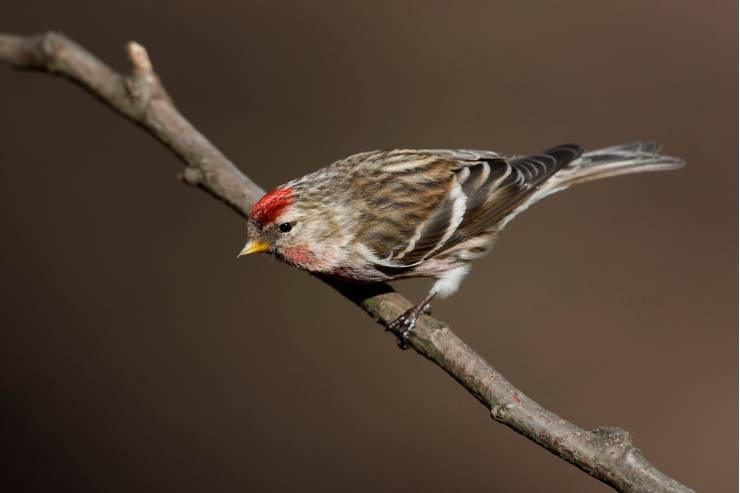
Size, weight, wingspan, lifespan, and conservation status of Lesser Redpoll:
- Size: 11.5-12.5 centimeters (4.5-4.9 inches)
- Wingspan: 20-22.5 centimeters (7.8-8.9 inches)
- Weight: 9–12 grams (0.32-0.42 oz)
- Life span: 2–3 years
- Conservation status: Least concern
Habitat: The lesser redpoll is found in forests and mixed and coniferous woodlands, especially in areas with a high birch tree population.
It is also known for visiting gardens and parks and is drawn to seed feeders.
Lesser redpolls are usually seen in groups, especially in autumn and winter, when they mainly feed on birch catkins and search the ground for seeds.
Feeding: The smaller-beaked redpoll, or lesser redpoll, has a particular taste for nyger seed.
| Note: Nyger seed is a high-energy treat for these sensitive birds, and its fine texture makes it digestible. |
Conclusion
Lastly, the world of bird species reveals an exciting collection of birds marked by their earthy brown bodies and striking red heads, ranging from the vivid Red Avadavat to the Lesser Redpoll.
As we are in awe of these species’ beauty, we realize they are essential parts of ecosystems worldwide and emblems of artistic beauty.
We can protect these beautiful birds for future generations to treasure and enjoy by promoting appreciation and implementing conservation measures.
Frequently Asked Question
Which birds are brown-bodied with red heads?
Birds such as the Red Avadavat, House Finch, Cassin’s Finch, Red Junglefowl, and Lesser Redpoll have red heads and brown bodies.
Are these 5 red heads with brown bodies birds endangered?
The conservation status of these birds varies. Most of them are classified as species of the least concern, indicating stable populations.






